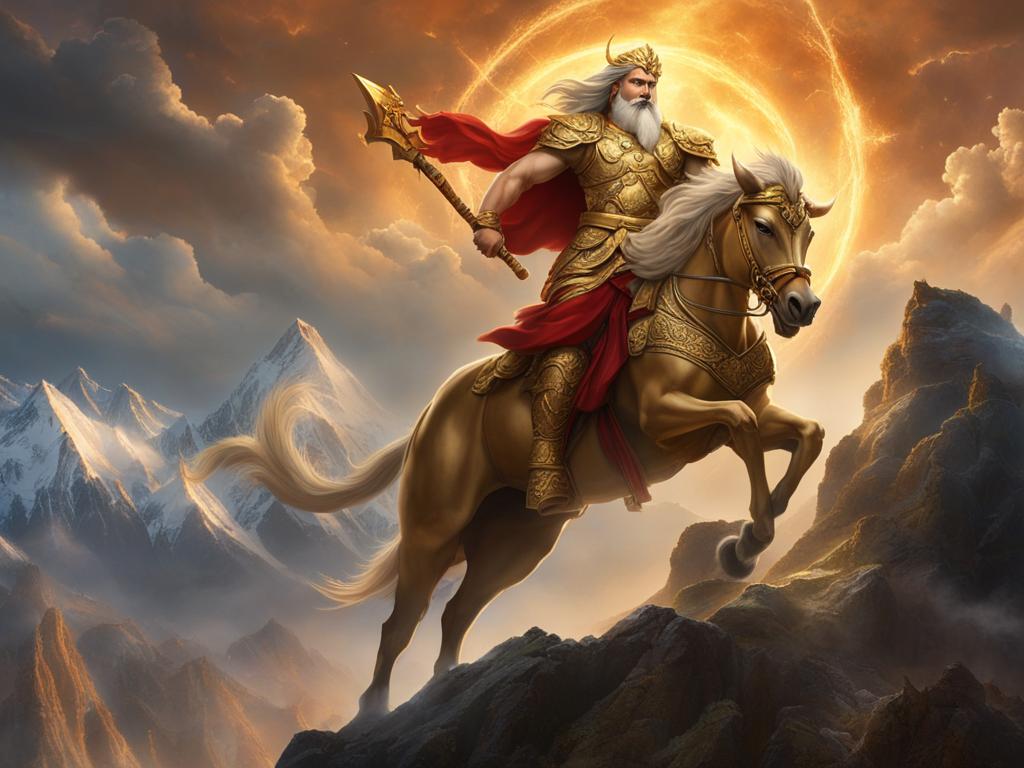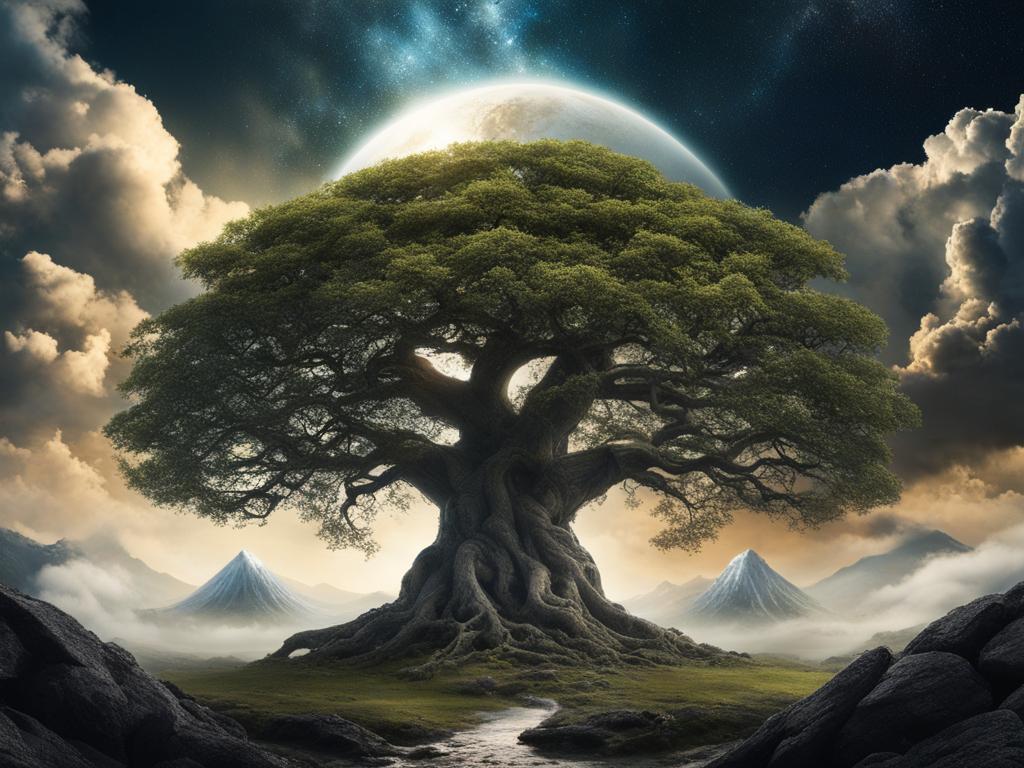Adverts
Welcome! On this journey, we will explore the fascinating secrets of Norse mythology. A Norse mythology is a rich and complex collection of stories and legends involving powerful gods, such as Thor It is Odin, a majestic mythical universe and a mysterious place called Valhalla. Get ready to dive into a world full of Norse myths and discover more about this unique ancient culture.
A Norse mythology is full of fascinating characters, from imposing gods to mythical creatures and cunning beings. As we explore these stories and legends, we will delve deeper into understanding this ancient culture that has influenced Scandinavian society for centuries. Prepare to be fascinated by the secrets that Norse mythology has to reveal.
Adverts
Key points to remember:
- Norse mythology is a rich collection of stories and legends involving powerful gods and mythical beings.
- Thor, Odin It is Loki are some of the norse gods best known and most influential.
- O Valhalla is a mysterious location in Norse mythology, associated with the bravery of dead warriors.
- The sacred tree Yggdrasil is a fundamental part of the universe of Norse mythology.
- Norse mythology continues to be a source of inspiration and fascination to this day.
Norse Gods and their ancient legends
Here, we will delve deeper into Norse mythology, getting to know the powerful norse gods, as Thor, the god of thunder, Odin, the king of the gods, and Loki, the cunning and malicious demigod. These are some of the most iconic and fascinating characters in Norse mythology, with stories involving courage, wisdom, betrayal and many adventures.
Thor, known for wielding the hammer Mjolnir, is worshiped as the god of thunder and strength. He is portrayed as a courageous warrior, always ready to protect the gods and humans from giants and other threats. His extraordinary strength and skill as a combatant make him one of the most loved and revered norse gods.
Adverts
Odin, the king of the gods, is considered the god of wisdom, magic and war. He has a complex personality, being a wise and cunning god, but also ruthless when necessary. Odin is often depicted with his single eye and his two ravens, Huginn and Muninn, who fly around the world and bring him valuable information. His search for knowledge and his incessant search for wisdom are striking characteristics of his personality.
Loki, in turn, is a mischievous and treacherous god. He is known for his changeable appearance and for being a master of illusion and trickery. Loki often causes trouble for the gods, but he is also responsible for helping them on some occasions. His unpredictable personality and quirky sense of humor make him one of the most interesting and captivating characters in Norse mythology.
Powerful and full of purpose, Thor, Odin and Loki play essential roles in the ancient legends of Norse mythology. Their stories shaped the culture and worldview of the Nordic people, transmitting values such as honor, courage and wisdom. Through these gods, we can learn about the challenges faced by the ancient Norse and the beliefs and myths that permeated their society.
Exploring the ancient legends surrounding these gods is diving into a magical era full of symbolism. These stories have stood the test of time and continue to delight and inspire people to this day.

Continue with us in the next section to discover more about the universe of Norse mythology and Yggdrasil, the sacred tree that connects the different kingdoms.
The Universe of Norse Mythology: Yggdrasil and its stories
In this section, we will explore the fascinating universe of Norse Mythology, with emphasis on Yggdrasil, the iconic sacred tree that connects the different worlds. Through the legends and stories involving this ancient tree, we will be able to understand the importance and meaning it has within the structure of the Norse universe.
Yggdrasil, also known as the “World Tree”, is a central figure in Norse Mythology. According to legends, it is located at the center of the Nine Worlds and its roots extend across different planes of existence, establishing a connection between the gods and other mythological beings.

Yggdrasil is believed to be responsible for sustaining and maintaining the order of the universe, being a vital element in Norse cosmology. Its name means “Odin’s Horse,” as the supreme god of the Norse often rode to the treetops to obtain divine wisdom.
To the norse legends They say that Yggdrasil has three main roots. The first extends to Asgard, the kingdom of the gods, the second to Jotunheim, the kingdom of the giants, and the third to Niflheim, the kingdom of the dead. These roots symbolize the tree's connection with different spheres of the universe and represent the balance between the different planes of existence.
The creatures that inhabit Yggdrasil
Around Yggdrasil, countless mythological creatures inhabit its branches and roots. Among them, the following stand out:
- Ratatoskr: a messenger squirrel that moves between the eagle that sits at the top of the tree and the snake Nidhogg, which stays at the roots.
- Nidhogg: a giant serpent that lives at the roots of Yggdrasil and gnaws at its branches, representing the cyclical destruction and renewal of the world.
- Veðrfölnir: a falcon that inhabits the crown of Yggdrasil and observes the world from its highest point.
Through these and other creatures, the norse legends present a complex and interconnected view of the universe, each being playing an essential role in maintaining cosmic order.
“Yggdrasil is the axis that supports life and death, the link between the different realms and the source of infinite stories to be discovered.” – Unknown author
The stories involving Yggdrasil are essential for understanding the richness and depth of Norse Mythology. This sacred tree is a link between gods, human beings and mythological creatures, constituting a symbolic representation of the interconnection and harmony present in the Norse universe.
| Aspects of Yggdrasil | Meaning |
|---|---|
| Sacred tree | Central representation of the structure of the Norse universe |
| Three main roots | Connection to Asgard, Jotunheim and Niflheim, the three fundamental realms of Norse cosmology |
| Inhabited by mythical creatures | Symbolism of the forces of nature and the interaction between the different kingdoms |
Conclusion
As we reach the end of this journey through Norse mythology, we can conclude that this ancient culture is rich in fascinating stories and legends. By knowing the Norse gods, their legends and the mythological universe through Yggdrasil, we are able to better appreciate and understand the influence of this mythology on our current society. Norse mythology continues to be a source of inspiration and fascination, spanning generations and perpetuating its unique and captivating legacy.
FAQ
What are the main gods in Norse mythology?
Some of the main gods in Norse mythology are Thor, Odin and Loki. Thor is the god of thunder, known for his strength and bravery. Odin is the king of the gods, possessing unparalleled wisdom and knowledge. Loki, in turn, is a cunning and malicious demigod.
What is Valhalla in Norse mythology?
Valhalla It is one of the most important places in Norse mythology. It is the hall of warriors killed in battle, where they are welcomed by the gods to live eternally in festivities and epic battles.
What is the role of Yggdrasil in Norse mythology?
Yggdrasil is the sacred tree in Norse mythology. She is responsible for connecting the different worlds of the Norse universe, serving as the structure that supports all existence. Yggdrasil is also associated with concepts of rebirth and growth.
